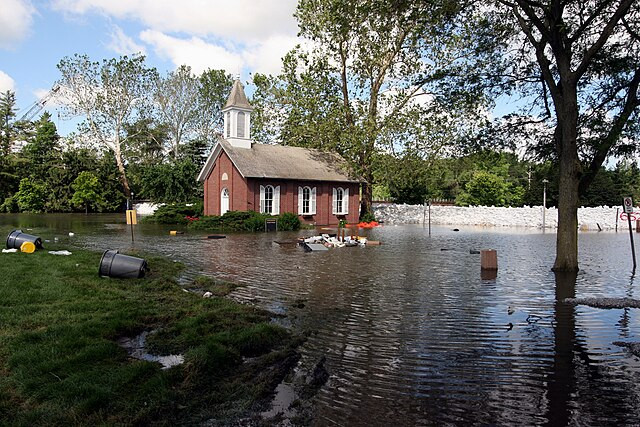Historic flooding wreaked havoc in northwest Iowa over the weekend, damaging nearly 2,000 properties and prompting widespread evacuations and disaster declarations. The deluge, fueled by heavy rainfall and overflowing rivers, has left communities grappling with significant damage and uncertainty.
"I can tell you that the devastation is severe and it's widespread," Iowa Governor Kim Reynolds said during a news conference in Des Moines on Sunday afternoon.
The flooding, which began on Saturday and continued into Sunday, was not solely the result of direct rainfall. National Weather Service (NWS) meteorologist Roger Vachalek explained that areas of northwest Iowa experienced up to 15 inches of rain over two days, compounded by flooding from overflowing rivers downstream. The convergence of precipitation from the Gulf of Mexico with a cool, low-pressure system moving from west to east resulted in this severe weather event.
As of Sunday, an official tally for weather-related deaths over the weekend was not yet available. However, fatalities have been reported in neighboring states. In Tucson, Arizona, a motorist stranded in monsoonal floodwaters was declared dead on Saturday. In South Dakota, an 87-year-old man driving a utility task vehicle died when it rolled down an embankment created by a washed-out roadway near Harrisburg.
KTIV's RJ Breen was in Spencer, Iowa Saturday where he saw just how bad the flooding was throughout the city. Below is just some of the video he took while in Spencer.
For our latest info on Spencer >> https://t.co/5ULlf18Oey pic.twitter.com/3LHHxDAfD4 — KTIV News Four (@ktivnews) June 23, 2024
The flooding in Iowa was exacerbated by already saturated ground, causing rapid and widespread inundation. Governor Reynolds highlighted the impact on farmland and the record-breaking flood levels at 16 locations across the state. "More than 1,000 Iowans needed shelter overnight, 1,900 properties across the state were damaged, and hundreds of residential properties were destroyed," Reynolds reported.
In the city of Spencer, home to over 11,000 residents, floodwaters cut off the community from the rest of the state, prompting evacuations to two city shelters. Spencer Fire Chief Jesse Coulson noted that city first responders, aided by neighboring departments, conducted 383 rescues since the flooding began. One person remained missing, possibly trapped in a flooded vehicle.
The Little Sioux River, which officials initially expected to crest at 17.5 feet, rose to an estimated 22.1 feet, surpassing a record set in 1953. Clay County Emergency Management Agency Coordinator Eric Tigges mentioned the challenge of obtaining accurate readings due to the flooding of electronic gauges. "The electronic gauge that the Iowa Flood Center put in was under water," Tigges said.
South Dakota also faced severe flooding, prompting Governor Kristi Noem to declare a statewide emergency. The Big Sioux River was expected to crest on Sunday night, leading state officials to close Interstate 29 in southeastern South Dakota to construct a temporary levee.
John Benson, Iowa's Director of Homeland Security and Emergency Management, urged residents to stay vigilant as the threat of severe weather continued. "The forecast calls for more rain in the coming week, and the river gauges in the Missouri River are quickly rising," Benson warned.
Governor Reynolds took an aerial tour of the affected region on Sunday, describing the devastation as both severe and widespread. The state has requested an expedited Presidential Major Disaster Declaration to secure additional federal assistance for nine counties and public assistance for 22 counties.
In addition to northwest Iowa, several other regions, including west-central Iowa, southwest Minnesota, northeast Nebraska, and parts of South Dakota, faced hazardous weather outlooks. The NWS reported that streams, creeks, and rivers were in "moderate to major flood stage leading to continued road closures."
As high pressure brought record temperatures to other parts of the country, including the mid-Atlantic and the Southwest, Iowa and surrounding states braced for further severe weather. Another cool wave moving in from the West was expected to clash with warm, wet air over the Great Plains and the Midwest, raising the possibility of more thunderstorms and flooding.
Governor Reynolds and state officials continue to monitor the situation closely, emphasizing the need for community support and resilience in the face of ongoing challenges. "We're going to recover from this," Spencer Mayor Steve Bomgaars said, reflecting a sentiment of determination and hope amid the disaster.






